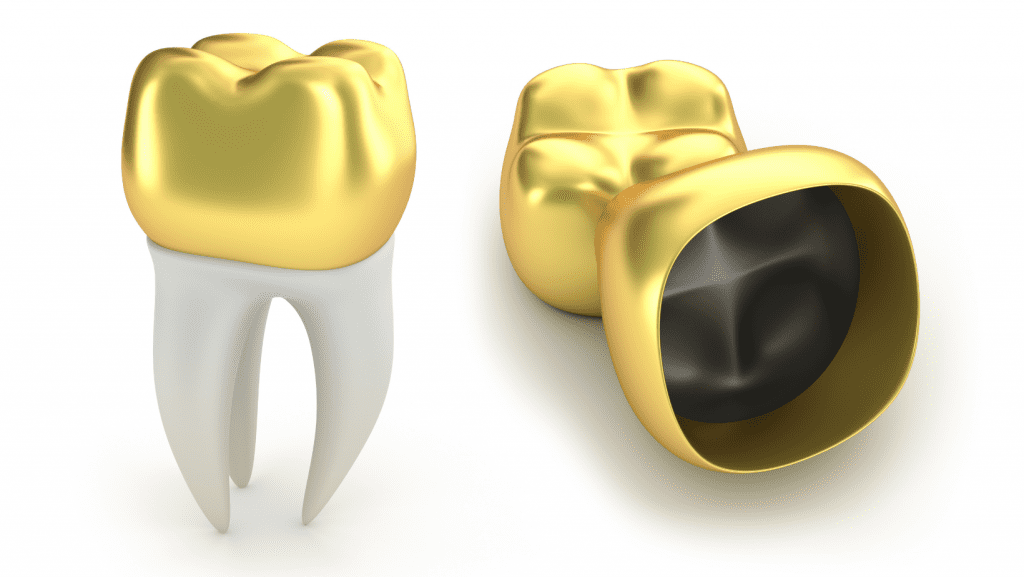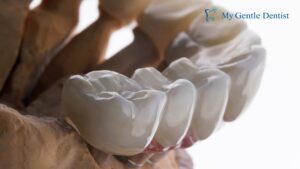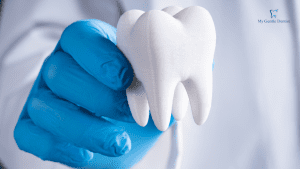If you are one of those people who are in the process of getting dental work done, then you might be wondering what the difference is between onlay and crown, both are the types of dental restoration. Both procedures are used to restore teeth that have been damaged, but they each have their own unique benefits. In this blog post, we will discuss the differences between onlays and crowns so that you can make an informed decision about which procedure is right for you!
What is an onlay and what is a crown?

An onlay is a type of dental restoration that is used to repair a tooth that has been damaged by decay or injury. Onlays are made from porcelain or composite material and are custom-made to fit the specific shape of your tooth. Onlays are bonded to the surface of your tooth using dental adhesive, and they can be used to restore a tooth that has been chipped, cracked, or broken.
A crown is a type of dental restoration that is used to cover an entire tooth. Crowns are made from porcelain or composite material and are custom-made to fit the specific shape of your tooth. Crowns are bonded to the surface of your tooth using dental adhesive, and they can be used to restore a tooth that has been chipped, cracked, or broken.
What’s the difference between an onlay and a crown?

The main difference is that an onlay covers just a portion of the tooth, while a crown covers the entire tooth. Onlays are typically used to repair a small area of damage, while crowns are used to repair large areas of damage. Crowns are also used to protect weak or damaged teeth from further tooth decay or injury.
Now that you know the difference between onlays and crowns, you can make an informed decision about which procedure is right for you. If you have a small area of damage, an onlay might be the best option. However, if you have a large area of damage, a crown might be the best option.
If you’re still not sure which procedure is right for you, talk to your dentist. They will be able to assess the damage to your tooth and recommend the best course of treatment.
When would you need an onlay or a crown, and which is better for you?
There are a few instances where you might need an onlay or a crown. If you have a large cavity, then a filling might not be enough to support your tooth. In this case, your dentist would likely recommend an onlay or a crown. Additionally, if you have had a root canal, an onlay or crown can help to protect your tooth from further decay. Finally, if you have a discolored or misshapen tooth, an onlay or crown can help to improve its appearance.
So, which is better for you? Well, it really depends on the situation. If you have a large cavity, then an onlay might be the best option. Onlays are less invasive than crowns and can help to preserve more of your natural tooth. However, if you have had a root canal or your tooth is significantly misshapen, then a crown might be the best option. Crowns are more invasive than onlays, but they can provide better support for your tooth.
Which one is right for you depends on the extent of damage to your tooth, as well as your budget and oral health goals.
In some cases, a simple filling may be all that is necessary to restore your tooth. However, if the damage is more extensive, you may need a crown.
Crowns are more expensive than fillings, but they offer a number of advantages. First, they are much stronger and can protect your tooth from further damage. Second, they can be used to improve the appearance of your tooth. If you are unhappy with the way your tooth looks, a crown can give it a whole new look.
If you have extensive damage to your tooth, then a crown may be the best dental restoration option.

A crown can help to restore your tooth to its original shape and size, and can also help to improve its appearance. If you are considering a crown, then it is important to talk to your dentist about the best option for you.
Crowns are made from a variety of materials, including porcelain, ceramic, and metal. Your dentist will help you to choose the best material for your needs. Porcelain crowns are made to match the color of your natural teeth, and they are also very strong. Ceramic crowns are also made to match the color of your natural teeth, but they are not as strong as porcelain crowns. Metal crowns are the strongest type of crown, but they are also the most visible.
Your dentist will take x-rays and impressions of your teeth in order to make sure that the crown fits properly. Once the crown is made, your dentist will bond it to your tooth with a special adhesive. It is important to care for your crown properly in order to keep it looking its best. You should brush and floss your teeth as you would normally, and you should also avoid chewing on hard objects.
If you only have a small amount of damage, then an onlay may be a better dental restoration option.
This is because an onlay will preserve more of your tooth structure. It is also less likely to cause problems with your bite. If you have a lot of damage, then a crown may be the best option.
Another reason to choose an onlay over a crown is that it is less invasive. This means that it requires less drilling of your tooth. It is also a simpler procedure, which means it will take less time and be less expensive.
If you are unsure whether an onlay or crown is right for you, then ask your dentist. They will be able to assess the damage to your tooth and give you the best option for treatment.
Onlays are also known as partial crowns. They are made of porcelain, gold, or composite resin. They are custom-made to fit your tooth and bond directly to the tooth structure. Crowns are also known as full crowns. They completely encase the tooth and are made of porcelain, gold, or metal.
What are the risks associated with getting an onlay or a crown, and how can you minimize them?
There are a few risks associated with getting an onlay or a crown, but they can be minimized with proper care. The first risk is that the onlay or crown could become loose and fall out. This can be prevented by making sure to brush and floss regularly, and by avoiding chewing hard foods. The second risk is that the onlay or crown could break. This can be prevented by avoiding chewing on hard objects, and by getting regular dental checkups. The third risk is that the onlay or crown could cause tooth decay. This can be prevented by brushing and flossing regularly, and by avoiding sugary foods and drinks.
If you take proper care of your onlay or crown, you can minimize the risks and enjoy many years of use. If you have any concerns, be sure to talk to your dentist. They will be able to help you keep your onlay or crown in good condition.
Read More – Gum Disease Treatment, Dental Cosmetic Treatment, Dental Fillings, Root Canal Procedure and Dental Implant treatment





